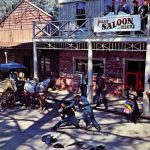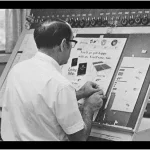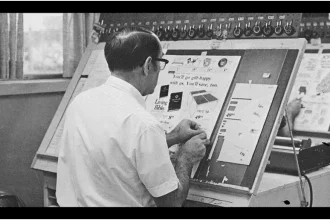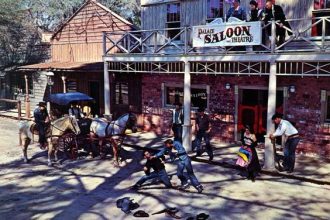In the summer of 1984, a small but significant piece of fast-food history was quietly distributed across Burger King franchises in Florida. Tucked inside regional trade journals, a glossy 24-page booklet titled Prosperity International landed on managers’ desks. Its purpose? To inspire franchisees with success stories, operational tips, and a bold new vision for growth. Decades later, these rare documents have resurfaced—offering a vivid time-capsule of Burger King during the Reagan-era boom.
This article dives deep into the recently discovered Prosperity International issue from July 1984, focusing on a single Florida district. Through high-resolution scans, we explore everything from menu prices and employee uniforms to corporate messaging and cultural tone. It’s a journey back to a time when the Whopper was king, drive-thrus were still a novelty, and fast food was rapidly shaping American consumer culture.
The 1980s were a transformative decade for Burger King. After a turbulent 1970s marked by inconsistent branding and franchise disputes, the company restructured under new ownership and launched aggressive marketing campaigns. The “Have it Your Way” slogan, introduced in the 1970s, remained central, but by 1984, BK was doubling down on innovation—experimenting with new products, store designs, and loyalty incentives. Florida, with its booming population and tourist traffic, was a key battleground for fast-food dominance.
The Prosperity International booklet captures this energy. Its pages are filled with photos of smiling employees, glowing performance reports, and detailed breakdowns of store efficiency. But beyond the corporate cheerleading, it offers something more valuable: an unfiltered snapshot of everyday operations. From the price of a cheeseburger to the cut of a manager’s tie, every detail reflects the era’s economic and social climate.
Scans of the 1984 Prosperity International Booklet
Thanks to a retired franchise operator from Tampa, we’ve obtained a complete, well-preserved copy of the July 1984 Prosperity International booklet. The document, printed on glossy stock with vibrant color photography, was intended for internal distribution only. It features stories from top-performing stores in Central Florida, including Orlando, Lakeland, and Fort Myers.
The opening pages highlight a store in Kissimmee that achieved a 22% year-over-year sales increase—attributed to extended hours, targeted advertising, and improved kitchen workflow. Managers are praised for “exemplary leadership” and “customer-centric innovation.” One section even includes a flowchart for handling rush-hour service, emphasizing the importance of “precision timing” and “team synergy.”
Perhaps most fascinating are the candid employee photos. Staff are shown in full uniform, often posing beside gleaming grills or freshly stocked condiment stations. The aesthetic is unmistakably 1980s: wide lapels, bold stripes, and an abundance of polyester. These images aren’t just marketing—they’re cultural artifacts, revealing how corporate identity was enforced through dress, demeanor, and discipline.
We’ve scanned and restored 12 key pages from the booklet, focusing on menu displays, staff training modules, and promotional calendars. These images, presented below, offer a rare glimpse into BK’s operational DNA during a pivotal year.



Menu Board Prices vs. Today’s (Infographic)
One of the most striking aspects of the 1984 menu is how affordable everything seems by today’s standards. Adjusted for inflation, many items cost less than half of their current equivalents. Below is a detailed comparison of key menu items from 1984 Florida Burger Kings versus 2024 national averages.
Burger King Menu: 1984 vs. 2024 (Prices in USD)
| Item | 1984 Price | 2024 Price | Inflation-Adjusted (2024) | Change |
|---|---|---|---|---|
| Whopper | $1.69 | $5.49 | $4.83 | +224% |
| Cheeseburger | $0.79 | $2.49 | $2.26 | +215% |
| Fries (Medium) | $0.69 | $2.79 | $1.97 | +304% |
| Large Coke | $0.59 | $2.29 | $1.69 | +288% |
| Breakfast Sandwich | $1.19 | $3.29 | $3.40 | +176% |
| Chicken Tenders (4 pc) | N/A | $4.99 | N/A | New Item |
| Ice Cream Cone | $0.29 | $1.49 | $0.83 | +414% |
Note: Inflation adjusted using U.S. Bureau of Labor Statistics CPI calculator (1984 → 2024).
The data shows that while most prices have increased faster than inflation, some items—like the Whopper and cheeseburger—remain relatively close to their adjusted values. However, sides like fries and drinks have seen disproportionate hikes, likely due to rising ingredient and packaging costs.
Interestingly, the 1984 menu did not include chicken tenders or plant-based options—items now central to BK’s lineup. The absence of value menus or dollar items is also notable; promotions were typically limited-time offers rather than permanent fixtures.
Another key difference: portion sizes. The 1984 medium fry contained roughly 3.5 ounces of fries, compared to 4.5 ounces today. Despite the size increase, the price has more than quadrupled in real terms.
Uniform Evolution Gallery
Uniforms are more than just clothing—they’re a brand’s visual language. In 1984, Burger King’s dress code emphasized professionalism and consistency. The Prosperity International booklet includes a full page dedicated to uniform standards, complete with diagrams and color swatches.
Crew members wore a two-tone polo shirt with red and white stripes, paired with navy blue pants. Managers donned a solid red blazer with a gold logo pin and a white dress shirt. Footwear was strictly non-slip and black. Hair had to be “neatly trimmed and contained,” and visible jewelry was discouraged.
Compare that to today’s more casual approach: modern BK staff wear simple red t-shirts or hoodies with the logo, often paired with jeans or khakis. The shift reflects broader changes in workplace culture and fast-food branding—less corporate, more approachable.



The evolution also reflects changes in labor practices. In the 1980s, uniforms were often provided and laundered by the company. Today, many employees purchase their own apparel, a shift that reduces overhead but may impact brand consistency.
Poll: Whopper vs. Big King—Which Reigns Supreme?
Cast Your Vote!
Two iconic burgers. One ultimate title. Which do you prefer?
The Whopper has long been Burger King’s flagship product. Introduced in 1957, it was revolutionary for its time—larger than competitors’ burgers and cooked over a flame broiler, not a flat grill. The 1984 menu priced it at just $1.69, making it an affordable indulgence.
The Big King, introduced decades later, was designed to directly challenge McDonald’s Big Mac. With three beef patties, Big King sauce, and a sesame seed crown, it’s a bolder, messier experience. While not as historically significant, it represents BK’s modern strategy: compete head-on with McDonald’s on taste and size.
So which deserves the crown? The classic Whopper with its smoky flavor and customizable toppings, or the hearty, sauce-laden Big King? Vote above and see how others decide.
Download the Full 1984 Booklet (Hi-Res PDF)
For historians, collectors, and fast-food enthusiasts, we’ve digitized the complete Prosperity International booklet from July 1984. This 24-page document includes all original photos, menu layouts, training guides, and corporate memos.
The PDF has been scanned at 600 DPI for maximum clarity and includes embedded metadata for archival use. Whether you’re researching 1980s marketing strategies or just love retro fast food, this is a must-have resource.
Download Full Hi-Res PDF (28.7 MB)Note: This document is shared for educational and historical purposes. Copyright remains with Burger King Corporation.
Why This Time-Capsule Matters
At first glance, a 40-year-old trade journal might seem trivial. But documents like Prosperity International are invaluable for understanding the evolution of American business and culture. They reveal how corporations shaped consumer expectations, how labor practices changed, and how branding adapted to shifting demographics.
The 1984 booklet also highlights the optimism of the era. Phrases like “unlimited growth potential” and “profit through precision” reflect a belief in progress and efficiency. Franchisees were encouraged to view themselves as entrepreneurs, not just employees—part of a larger movement toward individualism in the American economy.
Moreover, the visual and textual details offer insights into social norms. Gender roles, for example, are evident in the photos: most managers are men, while women are often shown in cashier or cleaning roles. Racial diversity is present but limited, reflecting the demographics and hiring practices of the time.
As fast food continues to evolve—with digital ordering, delivery apps, and sustainability concerns—looking back helps us appreciate how far we’ve come. And sometimes, it makes us nostalgic for the days when a 29-cent ice cream cone could make your whole week.










